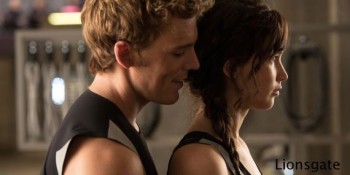Whenever any work is adapted into another medium, a backlash is to be expected from purists who want to see the work copied to the letter. Certainly, there has been a fury from people offended that Hugh Jackman is not five feet tall when playing Wolverine and from Twilight fans upset that even Kristen Stewart’s terrible acting isn’t bad enough to capture how truly awful a person Bella Swan is.
Hunger Games: Catching Fire deserves no such backlash.
A movie adaptation is a retelling of a story in a different medium, which requires different sensibilities. The Hunger Games books are written completely in first-person perspective. Author Suzanne Collins created a main character, Katniss Everdeen, whose thoughts about how the people watching the Games on television must be reacting. Her thoughts are informed only by her own experiences, and the reader is unable to know whether or not Katniss is correct. In addition to creating a protagonist with a limited perspective, such a format doesn’t allow for many secondary story lines or varying points of view.
The original Hunger Games movie added much to the story to get around these limitations of first-person perspective. The writers inserted scenes showing Katniss’s mentor, Haymitch Abernathy, at work seeking sponsors for the girl, as opposed to the book’s telling in which Katniss mentions she is surprised to learn Haymitch was looking out for her well-being. The book also lacked much foreshadowing for future stories, ignoring the impact of the young heroine’s actions in the arena until the end of the story. The movie fixed this with scenes displaying the effect of Katniss’s more defiant actions in the arena. Katniss Everdeen’s decisions spark a revolution.
Unfortunately, the silver screen presents its own limitations. While the original movie was able to make the viewer question fellow competitor Peeta’s motives throughout, it was unable to capture the cynical decisions made by Katniss. The movie-goer who had not read the books would be led to believe that Katniss truly loved Peeta, while the source material makes it evident that Katniss is a calculating woman, doing everything necessary to survive. If Katniss loves Peeta at all, it’s a feeling that the reader may recognize, but that Katniss is unwilling to admit to herself.
Catching Fire is a fantastic book. Many fans have read the book in one sitting. With that in mind, it’s easy to see how the Hunger Games film could frustrate fans. I am happy to report that Catching Fire is a strong and faithful adaptation of the source material.
Catching Fire avoids all of the problems of the original Hunger Games movie. From the first scene, Katniss clarifies her relationship with Peeta by immediately friend-zoning him. And to Peeta’s credit, he doesn’t respond by calling her names on the Internet. Instead, Peeta understands Katniss’s motives and continues the charade to keep the Capitol happy. That necessary deception pushes the entire plot forward as Katniss tries to prevent the revolution that she helped set in motion.
This leads to several heartbreaking scenes, culminating in the execution of President Snow’s brilliant vengeance. Snow’s plan: make Katniss compete in the Hunger Games again. This scene was easily the best of the first half of the book. In one move, the entire plot was set in motion while showing Snow to be a demonic man. The movie did this scene justice, even if the trailers spoiled what was a fantastic twist in the original story.
The announcement of the Quarter Quell sets the stage for the rest of the movie. Unlike the first Hunger Games she competed in, Katniss is no longer fighting other children. Every contestant in the arena is a former victor of the Games, and none of them are happy with the Capitol’s move.
Without giving away any more about the plot, I have to say that the execution of the entire movie was impressive. The adaptation accurately portrayed the spirit of the book, and any changes to the text were hardly noticeable. Fans of the book know that the new Hunger Games arena is far more impressive than the first, and thankfully, most of the major elements of the arena come into play in a big way. Yes, even the monkeys.
Without a doubt, the best part of the story is its foreshadowing, and if you’re watching the movie without having read the book, I strongly recommend watching carefully and asking questions. It will make your experience much more enriching.
Catching Fire ends in a big way and will get you very excited for the Mockingjay movies. Unfortunately, since Harry Potter proved you can make twice as much money off of one story if you split it in half, every studio has made it standard operating procedure. The Mockingjay book was also easily the worst book of the trilogy, but its biggest problem was its briskness and complete lack of detail to all of the major events in Panem. With two movies, it’s conceivable that these problems could be fixed as the longer screen time allows them to flesh out the details brushed over in the book.
Catching Fire has been a critical and commercial success, receiving a “fresh” score of 90 percent on Rotten Tomatoes and making over $800 million at the worldwide box office while becoming the highest grossing U.S. domestic film of 2013.
Jennifer Lawrence is an American treasure. She doesn’t make a bad movie. Her appearance in this flick alone should convince you to give it a shot. A very impressive list of “H” names rounds out the cast, including the late Philip Seymour Hoffman, Woody Harrelson, Josh Hutcherson, Liam Hemsworth, and Stan “Silent H” Tucci.
Add in the fact that Suzanne Collins wrote a great series, and that Catching Fire is probably the best of the trilogy, and you’re practically guaranteed a great movie. Thankfully, Catching Fire doesn’t let us down, and is a tremendous movie that can be watched over again without losing its value.
